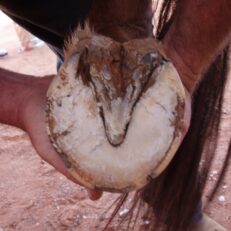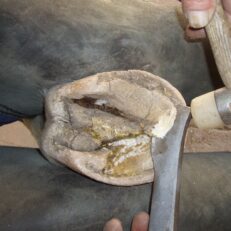Horses’ hooves are a natural barometer in tune with nature, and if we as hoof carers can also tune into nature and be vigilant and observant, it will be noticed that the sole and the hoof wall have reacted differently in this current climate to protect itself from the prolonged dry conditions.
Let us consider the sole first, as this is the first part we should address when preparing any hoof. In a normal year the sole will grow thicker as the hoof wall grows down, then it begins to get crumbly and (with a bit of help from the ground surfaces and encouragement from a sole knife) it will exfoliate to give the sole a concave appearance. The hoof wall is then left longer above the sole to bear weight as it is intended to do, and only needs to be trimmed into shape to control any external flaring.
However because of the long dry period we are experiencing now, Mother Nature has hedged her bets as to when the ground surfaces are ever going to be soft again, and so is not allowing the old sole to come away, giving the hoof more protection from underneath. This has had the resultant effect of also allowing the hoof wall to become longer and in some cases more flared at the toe and the sides and as a result the horse’s mobility becomes very unstable. (Pic 1)
It is at this point where we need to intervene in order to restore the natural flexibility of the hoof. The barefoot trimmers incorrectly maintain that the horse needs heaps of sole callous and they won’t remove it. However, sole callous builds up for the reasons I have explained, and when it has gone too far it results in big ugly hooves and lack of mobility.
As an indication of just how we have messed up the workings of Mother Nature, go and open the stable gate and allow the horse to go wherever it chooses and you will see it head for the nearest dam, to soak its hooves and get some flexibility back in the soles and walls by rehydrating them with water, and in a short space of time all excess sole build up will drop out leaving a free moving concave sole.
However this creates a problem with the hoof wall, as it is long and totally unprotected by the now exfoliated sole and it will either split between the flares or break away and tear unevenly often causing lameness (Pic 2) so it must be trimmed to eliminate this stress. If the hoof is to be left unshod, leave three to four millimetres of wall above the trimmed sole or for shoe preparation one millimetre above the trimmed sole. (Pic 3)
The resolution of the problem of excess sole buildup in these dry times is quite simple. Remove excess sole when it becomes weight bearing especially in the bar area as the bars will bend outwards and crack and become infected. When the sole is too hard and dry to be taken out with a sole knife it must still be removed, so delicately use a sole chisel and hammer (Pic 4) to get under the crusty old sole and bar; it will come away easily if it is ready to, then you can control the hoof wall length and avoid costly flaring problems, and you will still be working within nature’s requirements. (The sole chisel is one of the most effective tools used by farriers in the past, but sadly it is mostly unheard of nowadays.)
If you should dare to trim the hoof wall back into shape for unshod or shod preparation without first preparing the sole you are making the horse bear weight on its sole and it will very soon develop bruising in that area.
I have seen countless horses lately with bumbly action problems where all I have had to do is remove the excess sole and overgrown bars to rectify this. The standard excuse that ‘it is too hard and dry so I will leave it there till next time’ is just not good enough for the horse.




